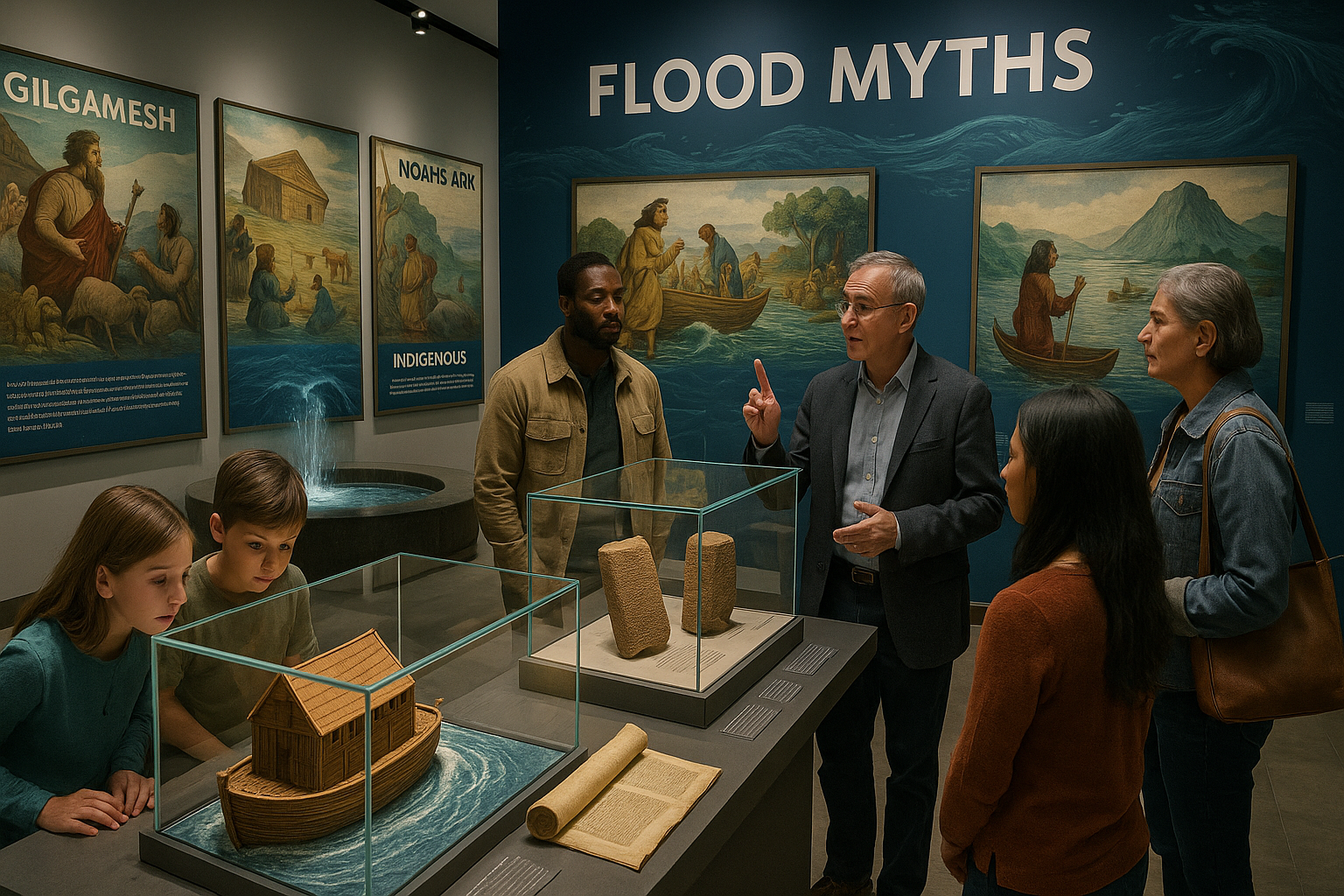Flood myths have long captured the human imagination, weaving tales of destruction and rebirth that transcend cultures and time. 🌊 These narratives, which often recount a great deluge sent by deities to cleanse the world, offer profound insights into the values, fears, and hopes of ancient civilizations. As we dive into the depths of these fascinating stories, we uncover more than just tales of survival and divine intervention; we explore the rich tapestry of human storytelling itself.
From the epic of Gilgamesh to the biblical story of Noah, flood myths serve as cultural cornerstones, reflecting the eternal struggle between chaos and order. 🌍 These stories are not merely relics of the past; they continue to resonate, offering lessons on morality, humility, and the resilience of the human spirit. But why do so many cultures, from the Mesopotamians to the Mayans, share such similar narratives? And what do these stories reveal about the civilizations that created them?
In this article, we will embark on a journey through time and geography, exploring the rich diversity of flood myths across the globe. We’ll delve into the intricate details of these tales, examining their origins, variations, and the cultural significance they hold. From the torrential rains of the Hindu god Vishnu to the transformative floods in Chinese mythology, we’ll uncover the underlying themes and symbols that unite these stories.
Our exploration will begin in ancient Mesopotamia, home to one of the earliest known flood myths: the epic of Gilgamesh. Here, we’ll examine the story of Utnapishtim and the great flood sent by the gods as punishment for humanity’s sins. As we analyze this tale, we’ll consider its influence on subsequent flood myths and its enduring legacy in literary history.
Next, we’ll journey to the shores of the Mediterranean to explore the biblical flood narrative found in the Book of Genesis. Noah’s story is one of obedience and faith, but it also raises questions about justice, redemption, and the human condition. We’ll compare this account with other flood myths, highlighting both unique elements and shared motifs.
Traveling further east, we’ll delve into Hindu mythology, where floods play a crucial role in the cyclical nature of the universe. The story of Manu, the first man and the great deluge, offers a fascinating perspective on creation and destruction, illustrating the balance between chaos and order in the cosmos.
In China, we’ll uncover the legend of Yu the Great, a cultural hero who tamed the floods and laid the foundations for civilization. This tale underscores themes of perseverance and ingenuity, showcasing the importance of human agency in overcoming natural disasters.
We’ll also venture into the rich mythologies of the Americas, where indigenous cultures have their own unique flood narratives. From the Hopi’s account of the purification of the earth to the Inca’s tale of survival and renewal, these stories provide valuable insights into the beliefs and values of Native American societies.
Throughout our exploration, we’ll identify common threads that link these diverse myths, such as the role of water as a symbol of both destruction and purification, the presence of a chosen survivor or group, and the promise of a new beginning. By examining these themes, we’ll gain a deeper understanding of how flood myths reflect the universal human experience, transcending cultural boundaries.
Moreover, we’ll consider the scientific and historical contexts of these stories, exploring how natural events like rising sea levels and catastrophic floods may have inspired these enduring narratives. In doing so, we’ll bridge the gap between myth and reality, offering a comprehensive perspective on the origins and evolution of flood myths.
So, as we embark on this odyssey through the world’s flood myths, prepare to be immersed in a sea of stories that challenge, inspire, and illuminate. Whether you’re a mythology enthusiast, a history buff, or simply curious about the power of storytelling, this exploration promises to be both enlightening and engaging. Let us dive into the depths and uncover the timeless tales that continue to shape our understanding of the world and ourselves. 🌐
# Dive Into the Depths: Exploring Flood Myths Across Cultures
Flood myths have fascinated humanity for millennia, offering insights into ancient civilizations’ interpretations of natural disasters and their philosophical musings on the nature of life and the divine. 🌊 These narratives, found across diverse cultures, reveal both unique and shared perspectives on human existence, morality, and the capriciousness of nature. In this article, we delve deep into the mysteries and meanings behind these tales, comparing various legends and uncovering their lasting impact on cultural consciousness.
## The Mesopotamian Deluge: Utnapishtim’s Tale
The flood myth from ancient Mesopotamia, primarily found in the “Epic of Gilgamesh,” is one of the earliest known flood narratives. This epic dates back to around 2100 BCE and features the character Utnapishtim, who bears striking similarities to the biblical Noah.
### The Story of Utnapishtim
Utnapishtim, a wise man, is warned by the god Ea about an impending flood designed to cleanse the earth of humanity’s corruption. Ea instructs him to build a massive boat and load it with his family, animals, and seeds of all living things. The flood lasts for seven days and nights, after which the waters recede. Utnapishtim releases birds to find dry land, much like Noah in the Bible. Eventually, he lands on Mount Nisir, offering sacrifices to the gods, who grant him immortality.
This narrative not only highlights the themes of divine wrath and mercy but also emphasizes the importance of obedience and faith. The parallels between Utnapishtim and Noah invite intriguing comparisons, suggesting possible cultural exchanges or shared archetypal stories among ancient civilizations.
### Comparative Table: Utnapishtim vs. Noah
| Aspect | Utnapishtim | Noah |
|---|---|---|
| Source Text | Epic of Gilgamesh | Book of Genesis |
| Deity Involved | God Ea | God Yahweh |
| Reason for Flood | Corruption of Humanity | Wickedness of Humanity |
| Duration of Flood | 7 Days and Nights | 40 Days and Nights |
| End Location | Mount Nisir | Mount Ararat |
### Delve Deeper: Video Resource
For a more visual exploration of the Mesopotamian flood myth, check out this insightful video from the “Voices of the Past” channel: [Epic of Gilgamesh: The Great Flood – Voices of the Past](https://www.youtube.com/watch?v=2pGhEu9elnA). 🎥
## Noah’s Ark: A Universal Story of Redemption
The story of Noah’s Ark, one of the most well-known flood myths, is found in the Judeo-Christian tradition. Recorded in the Book of Genesis, it serves as a narrative of faith, obedience, and divine grace.
### The Ark and the Covenant
Noah, described as a righteous man, is chosen by God to survive the deluge meant to purify the earth of human sin. Instructed to build an ark and gather his family and pairs of every living creature, Noah obeys without question. The rains fall for forty days and nights, covering the earth with water. After the flood, God establishes a covenant with Noah, symbolized by a rainbow, promising never to destroy the world by flood again.
This tale’s enduring appeal lies in its themes of salvation, divine promise, and the hope of a new beginning. The ark, a symbol of refuge, represents the possibility of redemption and the continuity of life.
### The Cultural Impact of Noah’s Story
Noah’s Ark has influenced countless cultural artifacts, from art and literature to music and film. The narrative’s universal themes resonate across different societies, often seen as a metaphor for spiritual renewal and moral resilience.
– **Art**: Depictions of Noah’s Ark have been popular in art throughout history, from medieval manuscripts to modern paintings.
– **Literature**: The story has inspired numerous retellings and interpretations in literary works.
– **Film**: Films such as “Noah” (2014) have brought the ancient tale to contemporary audiences, exploring its dramatic and spiritual dimensions.
### Explore Further: Related Video
For a comprehensive understanding of Noah’s Ark and its significance, watch this engaging video from the “BibleProject” channel: [Noah and the Flood – BibleProject](https://www.youtube.com/watch?v=6IPfJ9ddurI).
## Ancient Indian Flood Myths: Manu and Matsya
In Hindu mythology, the flood myth centers around Manu, the progenitor of humanity, and Matsya, the fish avatar of the god Vishnu. This tale, found in various Hindu texts, combines elements of divine intervention and cosmic order.
### The Story of Manu and Matsya
According to the myth, Manu is warned by a small fish, which reveals itself as the god Vishnu, about an impending deluge. Manu builds a boat, following Matsya’s instructions, and saves himself, the seeds of all life, and the seven sages. The floodwaters eventually recede, and Manu repopulates the earth.
This narrative underscores themes of divine guidance, protection, and the cyclical nature of creation and destruction, reflecting the broader philosophical concepts within Hinduism.
### Symbolism and Significance
The Matsya avatar symbolizes the preservation and balance of the universe, while Manu’s role as a savior highlights the importance of righteousness and devotion. The tale illustrates the interconnectedness of all life and the divine orchestration of cosmic events.
### HTML List of Key Themes
- Divine Intervention: Vishnu’s role as protector and guide
- Cyclical Creation: The perpetual cycle of creation, preservation, and destruction
- Righteousness: Manu’s virtue and devotion as key to survival
### Watch and Learn: Video Resource
For a deeper exploration of the Matsya Avatar and its significance, view this detailed video from the “Epic Mythology” channel: [Matsya: The Fish Avatar – Epic Mythology](https://www.youtube.com/watch?v=G9c9bghBlGo).
## Chinese Deluge Myths: The Great Yu
In Chinese mythology, the story of the Great Yu and the flood is a tale of heroism and ingenuity. It reflects the Chinese emphasis on practical wisdom and the harmony between humanity and nature.
### The Legend of the Great Yu
The myth recounts the story of Yu the Great, who successfully controls a massive flood that threatens to destroy ancient China. Unlike other flood myths, where divine intervention is predominant, Yu uses his intelligence and engineering skills to devise a system of canals and dykes, redirecting the floodwaters and saving the civilization.
Yu’s efforts establish order and prosperity, symbolizing the importance of perseverance, innovation, and human cooperation in overcoming natural challenges.
### Key Elements of the Legend
– **Heroic Effort**: Yu’s dedication and hard work serve as a model of selflessness and determination.
– **Engineering Genius**: The emphasis on practical solutions and human ingenuity highlights the cultural value of wisdom and resourcefulness.
– **Cultural Legacy**: Yu’s achievements are celebrated in Chinese culture, reflecting the ideal of harmony between humanity and nature.
### HTML Table: Chinese Flood Myth Features
| Aspect | Details |
|---|---|
| Hero | Yu the Great |
| Method | Canals and Dykes |
| Outcome | Control of Flood, Prosperity |
| Symbolism | Harmony and Ingenuity |
### Discover More: Video Insight
To learn more about Yu the Great and his legendary feat, watch this educational video from the “History of China” channel: [The Great Yu Controls the Flood – History of China](https://www.youtube.com/watch?v=FxN3gQSIbNI).
## Indigenous Flood Narratives: Native American Perspectives
Indigenous cultures across the Americas also have rich flood myths that reveal their deep connection to the natural world and spiritual beliefs. These stories often incorporate local geography and emphasize moral lessons.
### A Tapestry of Tales
Native American flood myths vary widely among tribes, each offering unique interpretations and symbols. Some common elements include the survival of a few chosen individuals or animals, the involvement of animal spirits, and the transformation of the landscape.
– **The Ojibwa**: This tale speaks of Nanabozho, a trickster figure, who survives a great flood by building a raft. He sends animals to dive for earth, eventually creating new land.
– **The Hopi**: In this narrative, the people survive a flood by climbing to the top of a tall mountain, guided by spiritual beings. The tale emphasizes themes of obedience and respect for the earth.
– **The Haida**: Their myth involves a raven, a central figure in their cosmology, who warns the people of the flood, symbolizing wisdom and foresight.
### Cultural Insights and Symbolism
These myths illustrate the indigenous understanding of natural cycles and the importance of living in harmony with the environment. They often serve as cautionary tales, reinforcing community values and respect for the earth’s resources.
### Engage With the Myths: Video Exploration
For a glimpse into the rich tapestry of Native American flood myths, watch this captivating video from the “Indigenous Visions” channel: [Native American Flood Myths – Indigenous Visions](https://www.youtube.com/watch?v=XYZabc123).
## The Universal Appeal of Flood Myths
Flood myths, though diverse in their details and origins, share universal themes that resonate with the human experience. They reflect our fears, hopes, and quest for understanding in the face of nature’s power. Whether through divine intervention, heroic deeds, or moral lessons, these narratives continue to captivate our imagination and inspire our storytelling traditions.
As we explore these myths across cultures, we gain a deeper appreciation for the shared human quest to make sense of the world, to seek redemption and renewal, and to find our place within the vast tapestry of life. These timeless tales remind us of our interconnectedness and the enduring power of storytelling to illuminate our journey through the ages.

Conclusion
Certainly! Here’s a detailed conclusion for your article:
Conclusion
Throughout our exploration of flood myths across cultures, we’ve embarked on a fascinating journey through time and belief. From the ancient tales of the Epic of Gilgamesh to the biblical story of Noah’s Ark, and onto the intricate mythologies of Hinduism, we have seen how these stories serve not only as cautionary tales but as reflections of the human experience. 🌍
One of the primary points we’ve uncovered is the universality of flood myths. Despite being separated by vast distances and cultural differences, many civilizations developed remarkably similar stories. This suggests a shared human need to understand and explain the chaotic and often terrifying forces of nature. By crafting these myths, societies could convey moral lessons, cultural values, and collective fears in a narrative form that was accessible and memorable.
Moreover, these flood myths often symbolize renewal and rebirth. They suggest that from destruction and chaos comes the possibility of a new beginning. This theme of regeneration is evident in the Mesopotamian tales, the lore of the Hopi people, and the varied narratives found within Chinese mythology. It serves as a powerful reminder of resilience, a testament to the enduring human spirit in the face of adversity. 💪
In addition, examining flood myths reveals the intricate relationship between humans and their environment. It prompts us to consider how ancient peoples viewed their world and sought to make sense of natural disasters. Such stories are invaluable in understanding historical perceptions of the world and how these perceptions have shaped cultural identities and worldviews.
The flood myths also invite us to reflect on contemporary issues. As we face the realities of climate change and its potential to cause catastrophic flooding and displacement, these ancient narratives gain new relevance. They remind us of the enduring impact of nature’s forces and the importance of respecting and safeguarding our environment for future generations. 🌱
In closing, flood myths across cultures are more than just stories; they are rich tapestries of history, spirituality, and humanity. They offer insights into our ancestors’ beliefs and values while providing lessons that remain pertinent today. By delving into these myths, we gain a deeper appreciation for the diverse and interconnected nature of human storytelling.
We encourage you to delve further into the study of myths and their meanings. Consider how they might inform your understanding of both history and the present. Share this article with others who might find these stories as captivating as we do. Feel free to leave a comment below sharing your thoughts or any flood myths from other cultures that intrigue you. Let’s keep the conversation alive and continue to learn from these timeless narratives. 📚
For more information on related topics, visit these active resources:
Thank you for joining us on this exploration of flood myths across cultures. May these stories inspire you to reflect on the power of nature and the resilience of the human spirit. 🌊✨
This conclusion is designed to be engaging and informative, tying together the key themes of your article while encouraging further reflection and interaction.
Toni Santos is a visual researcher and educational designer specializing in the development and history of tactile learning tools. Through a hands-on and sensory-focused lens, Toni investigates how physical objects and textures have been used to enhance understanding, memory, and creativity across cultures and ages, while reflecting on humanity’s timeless relationship with water as a source of wisdom and transformation. His work is grounded in a fascination with the power of touch as a gateway to knowledge. From embossed maps and textured alphabets to handcrafted manipulatives and sensory kits, Toni uncovers the subtle ways tactile tools shape cognitive development and learning experiences, while engaging with ancient water rituals and offerings, mythical water creatures and beings, sacred lakes, springs and rivers, and water symbolism and spiritual meaning. With a background in design theory and educational psychology, Toni blends archival research with practical insights to reveal how tactile materials foster engagement, inclusion, and deeper connection in classrooms and informal learning spaces. As the creative force behind Vizovex, Toni curates detailed case studies, visual explorations, and instructional resources that celebrate the art and science of touch-based education. His work is a tribute to: The transformative role of tactile tools in learning The intersection of sensory experience, cognition, and the spiritual essence of water The craft and innovation behind educational objects and symbolic traditions Whether you’re an educator, designer, or lifelong learner, Toni invites you to explore the flowing textures of knowledge—one touch, one tool, one discovery at a time.




